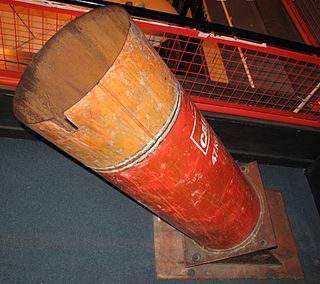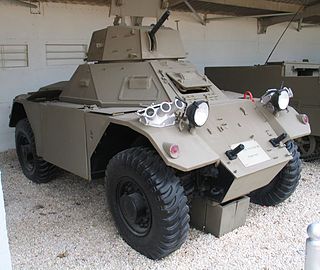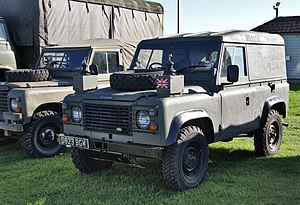The Ulster Defence Regiment (UDR) was an infantry regiment of the British Army established in 1970, with a comparatively short existence ending in 1992. Raised through public appeal, newspaper and television advertisements, their official role was the "defence of life or property in Northern Ireland against armed attack or sabotage" but unlike troops from Great Britain they were never used for "crowd control or riot duties in cities". At the time the UDR was the largest infantry regiment in the British Army, formed with seven battalions plus another four added within two years.

The East Tyrone Brigade of the Provisional Irish Republican Army (IRA), also known as the Tyrone/Monaghan Brigade was one of the most active republican paramilitary groups in Northern Ireland during "the Troubles". It is believed to have drawn its membership from across the eastern side of County Tyrone as well as north County Monaghan and south County Londonderry.
This is a chronology of activities by the Provisional Irish Republican Army (IRA) from 1970 to 1979.
The Troubles in Armagh recounts incidents during The Troubles in Armagh City, County Armagh, Northern Ireland; the violence was substantial enough for a stretch of road on the outskirts of the city to be referred to by one RUC officer as "Murder Mile". Over the course of the Troubles, although mainly concentrated in the years from 1969 until 1994, the small city of around 15,000 people, including some outlying areas, saw 86 deaths, including those of a number of people from the city who lost their lives elsewhere in Troubles-related incidents.

Barrack buster is the colloquial name given to several improvised mortars, developed in the 1990s by the engineering unit of the Provisional Irish Republican Army (IRA).

On 13 December 1989 the Provisional Irish Republican Army (IRA) attacked a British Army permanent vehicle checkpoint complex manned by the King's Own Scottish Borderers (KOSB) near the Northern Ireland–Republic of Ireland border at Derryard townland, a few miles north of Rosslea, County Fermanagh. The IRA unit, firing from the back of an armoured dump truck, attacked the small base with heavy machine-guns, grenades, anti-tank rockets and a flamethrower. A nearby Army patrol arrived at the scene and a fierce firefight erupted. The IRA withdrew after leaving a van bomb inside the complex, but the device did not fully detonate. The assault on the outpost left two soldiers dead and two wounded.

2nd Battalion, Ulster Defence Regiment was formed in 1970 as part of the seven original battalions specified in the Ulster Defence Regiment Act 1969, which received royal assent on 18 December 1969 and was brought into force on 1 January 1970. It was, along with the rest of the regiment, amalgamated with the Royal Irish Rangers in 1992 to form the Royal Irish Regiment. It had previously been amalgamated in 1991 with the 11th Battalion Ulster Defence Regiment to form the 2nd/11th Battalion Ulster Defence Regiment.
This is a chronology of activities by the Provisional Irish Republican Army (IRA) from 1980 to 1989. For actions before and after this period see Chronology of Provisional Irish Republican Army actions.
This is a chronology of activities by the Provisional Irish Republican Army (IRA), from 1992 to 1999.

On 19 March 1994, a British Army Lynx helicopter was shot down by the Provisional Irish Republican Army (IRA) in Northern Ireland. A unit of the IRA's South Armagh Brigade fired a heavy improvised mortar at the British Army base in Crossmaglen, County Armagh. The mortar round hit and shot down the helicopter, serial number ZD275, while it was hovering over the helipad. Three British soldiers and a Royal Ulster Constabulary (RUC) member were wounded.

On 11 February 1990, an active service unit of the Provisional IRA East Tyrone Brigade shot down a British Army Gazelle helicopter along the border between Northern Ireland and the Republic of Ireland. It took place between Augher in County Tyrone and Derrygorry in County Monaghan. The helicopter was hit several times by heavy machine-gun fire and crash-landed on an open field, injuring three members of its crew of four.

The Coagh ambush was a military confrontation that took place in County Tyrone, Northern Ireland, on 3 June 1991, during The Troubles, when a Provisional Irish Republican Army (IRA) active service unit from its East Tyrone Brigade was ambushed by the British Army's Special Air Service (SAS) at the village of Coagh, in County Tyrone, whilst on its way to kill a part-time member of the Ulster Defence Regiment (UDR). The ambush resulted in the deaths of all three IRA men involved.

In the Ballygawley land mine attack of 13 July 1983, four soldiers of the British Army's Ulster Defence Regiment (UDR) were killed by a Provisional Irish Republican Army (IRA) land mine near Ballygawley in County Tyrone, Northern Ireland. The soldiers were travelling in a convoy of armoured vehicles when the land mine was detonated remotely.
On 9 April 1990, the South Down Brigade of the Provisional Irish Republican Army (IRA) detonated a massive improvised land mine under a British Army convoy outside Downpatrick, County Down, Northern Ireland. Four soldiers of the Ulster Defence Regiment (UDR) were killed, the regiment's greatest loss of life since 1983.

On 2 May 1974 the Provisional Irish Republican Army (IRA) attacked a British Army base manned by the Ulster Defence Regiment (UDR) near the Northern Ireland–Republic of Ireland border at Clogher, County Tyrone. The IRA unit engaged the small base with automatic weapons, rockets and improvised mortars. Ferret armoured cars were deployed to the scene and a fierce firefight erupted. The IRA withdrew behind the border with the Republic. The assault on the outpost killed greenfinch Eva Martin and wounded another UDR soldier.

Throughout the protracted conflict in Northern Ireland (1960s-1998), the Provisional IRA developed a series of improvised mortars to attack British Army and Royal Ulster Constabulary (RUC) security bases. The organisation also purchased both light and heavy machine guns in order to hamper the British Army supply of border bases by helicopter. The IRA fitted vehicles, specially vans and trucks, with both types of weapons. Vans, trucks and tractors were modified to transport concealed improvised mortars to a launch area near the intended target and fire them, while light and heavy trucks were employed as firing platforms mounting machine guns, particularly M60s and DShKs. Improvised armoured vehicles and heavy equipment were also used to penetrate the perimeter of fortified security bases. The IRA vehicles were often disguised as belonging to civilian companies or even government agencies.

On 12 December 1993, a unit of the Provisional Irish Republican Army's (IRA) East Tyrone Brigade ambushed a two-men unmarked mobile patrol of the RUC in Fivemiletown, County Tyrone. Two constables were shot and killed instantly. A military helicopter was also fired at by a second IRA unit in the aftermath of the incident, during a follow-up operation launched in the surroundings of the town by both the British Army and the RUC. A number of suspects were questioned, but the perpetrators escaped successfully. The action occurred just three days before the Downing Street Declaration.
On 24 June 1972, in the rural townland of Crabarkey near Dungiven, the Provisional IRA detonated an improvised land mine, killing three British Army soldiers in a Land Rover. It was one of many such landmine attacks by the IRA in rural areas in the 1970s.
This is a chronology of activities by the Provisional Irish Republican Army (IRA), in 1990 and 1991.












